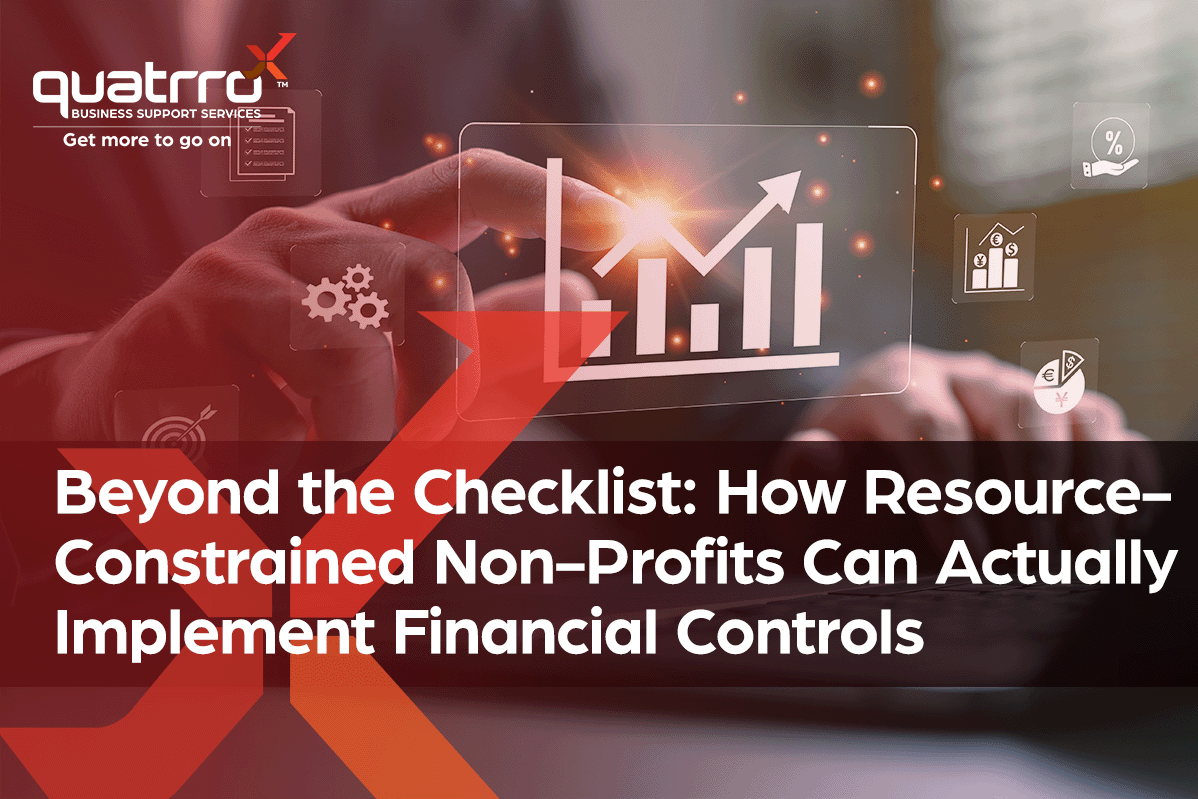Blog Details
Beyond the Checklist: How Resource-Constrained Non-Profits Can Actually Implement Financial Controls
November 26, 2025

By now, you’ve probably read the list. You know the 21 financial controls your non-profit should have. You probably nodded along, maybe even forwarded it to your Board treasurer or finance committee chair.
And then comes the inevitable question: “How are we supposed to do all of this with a two-person finance team?”
It’s the question we hear constantly from Executive Directors and CFOs at small to mid-sized non-profits. You’re stretched thin, wearing multiple hats, and now someone’s telling you that you need dual approvals, segregation of duties, and independent reviews.
Here’s the reality: Strong financial controls aren’t optional, regardless of your organization’s size. Donors, grantors, auditors, and your board expect them. But implementing them doesn’t have to break your budget or bury your team in directives and administrative nightmares.
The key is understanding that implementation is about strategy, not staff count.
Others face delayed audits because they can’t reconcile grant revenue to their general ledger, pushing completion past grant reporting deadlines and putting future funding at risk.
These aren’t worst-case scenarios. They’re reality when controls are treated as “nice to have” instead of essential infrastructure.
Instead, start with a risk-based approach to the list:
High-Risk, High-Impact Controls – Implement These First:
These prevent the fraud scenarios that can devastate your organization:
Medium-Risk Controls – Implement These Next:
Now you can move on the items on the list that can have the next largest impact on your organization’s longevity:
Leverage Your Board Strategically Your board members are already fiduciaries. Put them to work:
Use Technology as Your Second Set of Eyes Modern banking platforms and accounting systems can hard-code controls that used to require manual oversight:
Outsource Strategically Consider outsourcing specific control functions rather than entire departments if you are new to outsourcing:
Create Control Checkpoints for Routine Processes Build control verification into your monthly close process with clear ownership. Ensure bank reconciliations are completed by one person and reviewed by another. Make grant revenue reconciliation to the general ledger a standard step, not an afterthought.
Build Controls Into Your Calendar What gets scheduled gets done, so schedule recurring holds on your calendar for control activities. Some ideas of where to start:
“We need to formalize our financial controls. Not because we don’t trust our team, but because strong controls protect our mission, our reputation, and our people. This will require board involvement—specifically in signing authority, expense reviews, and periodic spot-checks. I’ve created a phased implementation plan that prioritizes the highest-risk areas first.”
Most boards will embrace this. They want to fulfill their fiduciary duties; they just need clear direction on how and where they should jump in.
If you encounter resistance, reframe it: “Our auditor expects these controls. Implementing them now, on our terms, is far better than scrambling to address audit findings later.”
Strong financial controls aren’t just about administrative burdens. They’re the foundation that allows you to grow sustainably, weather challenges, and maintain the trust that makes your work possible.
Whether you need fractional controller support to create segregation of duties, technology implementation that hard-codes controls into your workflow, or comprehensive control assessment and remediation, we bring both non-profit sector expertise and practical implementation experience.
Ready to move from checklist to implementation? Contact us to learn how we can help strengthen your financial infrastructure.
And then comes the inevitable question: “How are we supposed to do all of this with a two-person finance team?”
It’s the question we hear constantly from Executive Directors and CFOs at small to mid-sized non-profits. You’re stretched thin, wearing multiple hats, and now someone’s telling you that you need dual approvals, segregation of duties, and independent reviews.
Here’s the reality: Strong financial controls aren’t optional, regardless of your organization’s size. Donors, grantors, auditors, and your board expect them. But implementing them doesn’t have to break your budget or bury your team in directives and administrative nightmares.
The key is understanding that implementation is about strategy, not staff count.
The Real Cost of “We’ll Get to It Later”
When controls remain on the perpetual to-do list, the consequences are real. Organizations discover fraudulent wire transfers initiated by someone with both payment approval and bank access. Auditors flag material weaknesses or grants are put on hold pending remediation.Others face delayed audits because they can’t reconcile grant revenue to their general ledger, pushing completion past grant reporting deadlines and putting future funding at risk.
These aren’t worst-case scenarios. They’re reality when controls are treated as “nice to have” instead of essential infrastructure.
Start With Risk, Not the Full List
The mistake most organizations make is trying to implement all 21 controls simultaneously. That’s overwhelming and unnecessary.Instead, start with a risk-based approach to the list:
High-Risk, High-Impact Controls – Implement These First:
These prevent the fraud scenarios that can devastate your organization:
- Dual approval for significant transactions (wire transfers, ACH payments, large checks)
- Signing authority outside of the finance function
- Independent review of CEO/Executive Director expenditures
- Password-protected accounting system with approval requirements for retroactive changes
Medium-Risk Controls – Implement These Next:
Now you can move on the items on the list that can have the next largest impact on your organization’s longevity:
- Vendor authorization and verification before setup or changes
- Grant and contribution compliance monitoring
- Budget vs. actual monitoring for operating and capital expenditures
- Access control lists and two-factor authentication
- Documented financial policies and procedures
- Annual risk assessments
- Operating liquidity assessments
Solving the “Not Enough People” Problem
Segregation of duties is critical, but it doesn’t always mean hiring more staff. Here are practical workarounds:Leverage Your Board Strategically Your board members are already fiduciaries. Put them to work:
- Designate a board treasurer or finance committee member as a bank account signer (separate from staff)
- Assign board members to conduct read-only access reviews and frequent spot-checks of bank accounts and investments
- Rotate board members through regular reviews of ED/CEO credit card charges and reimbursements
Use Technology as Your Second Set of Eyes Modern banking platforms and accounting systems can hard-code controls that used to require manual oversight:
- Set up dual authorization requirements directly in your banking platform for significant transfers
- Use accounting software approval workflows requiring second party approval of journal entries
- Implement automated exception reports for payroll anomalies reviewed by someone outside payroll and finance
- Enable read-only access for board members to view transactions in real-time
Outsource Strategically Consider outsourcing specific control functions rather than entire departments if you are new to outsourcing:
- Independent payroll review by someone outside the payroll function
- Monthly financial close and reconciliation oversight
- Controller-level review of journal entries and adjustments
- Grant compliance tracking and reporting
Making It Operational, Not Theoretical
Controls fail when they exist only in policy manuals. They succeed when embedded in daily workflow. Here are some practical ideas for implementing controls:Create Control Checkpoints for Routine Processes Build control verification into your monthly close process with clear ownership. Ensure bank reconciliations are completed by one person and reviewed by another. Make grant revenue reconciliation to the general ledger a standard step, not an afterthought.
Build Controls Into Your Calendar What gets scheduled gets done, so schedule recurring holds on your calendar for control activities. Some ideas of where to start:
- Finance committees review ED expenses monthly
- Payroll exception reports get reviewed on a set schedule
- Board members conduct quarterly spot-checks of bank accounts
- Annual risk assessments and policy reviews
The Board Conversation That Must Happen
It is vital to have your Board aligned with what you are trying to accomplish with implementing controls, so here a rough outline of the conversation opener with them at your next board meeting:“We need to formalize our financial controls. Not because we don’t trust our team, but because strong controls protect our mission, our reputation, and our people. This will require board involvement—specifically in signing authority, expense reviews, and periodic spot-checks. I’ve created a phased implementation plan that prioritizes the highest-risk areas first.”
Most boards will embrace this. They want to fulfill their fiduciary duties; they just need clear direction on how and where they should jump in.
If you encounter resistance, reframe it: “Our auditor expects these controls. Implementing them now, on our terms, is far better than scrambling to address audit findings later.”
When to Bring in Outside Expertise
Consider specialized support from outside the organization when:- You’re preparing for significant growth or new funding sources with increased compliance requirements
- Your audit consistently includes findings related to internal controls
- You’re implementing new systems and need controls built in from the start
- Your team lacks bandwidth to both implement controls and maintain daily operations
- You need an independent assessment of your current control environment
From Compliance Burden to Strategic Asset
Going through the process of implementing strong financial controls delivers tangible benefits to your organization almost immediately:- Your audits become more efficient. When controls are functioning and documented, auditors spend less time testing and more time completing fieldwork.
- Your board gains confidence. Board members take on significant personal liability when accepting a Board position. Strong controls reduce their risk exposure and increase their confidence in operations.
- Your team experiences less stress. Clear processes with built-in checks and balances eliminate the ambiguity that comes with informal procedures. Staff know what’s expected and have protection when they follow proper procedures.
- Your donors trust you more. Most major donors increasingly ask about internal controls during due diligence. Being able to articulate your control environment sets you apart from others also asking for donations.
- You catch problems early. Controls surface errors, inefficiencies, and process breakdowns before they become material issues, or before they take down the organization.
Strong financial controls aren’t just about administrative burdens. They’re the foundation that allows you to grow sustainably, weather challenges, and maintain the trust that makes your work possible.
Partner With Experts Who Understand Non-Profit Realities
At Quatrro Business Support Services (QBSS), we’ve helped non-profit organizations implement practical, sustainable financial controls without overwhelming their teams or budgets. We understand that your resources are limited and your mission is urgent—which is why our approach focuses on risk-based, phased implementation that delivers protection without paralysis.Whether you need fractional controller support to create segregation of duties, technology implementation that hard-codes controls into your workflow, or comprehensive control assessment and remediation, we bring both non-profit sector expertise and practical implementation experience.
Ready to move from checklist to implementation? Contact us to learn how we can help strengthen your financial infrastructure.
Latest Insights
Related Blogs
Contact Us







